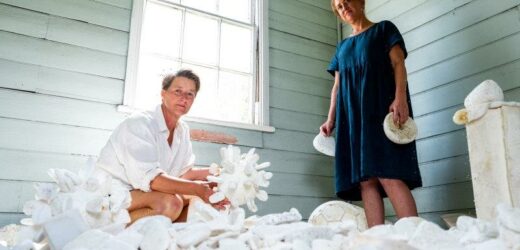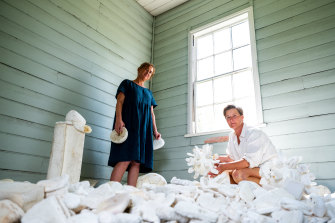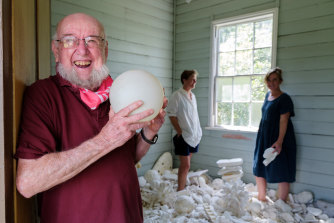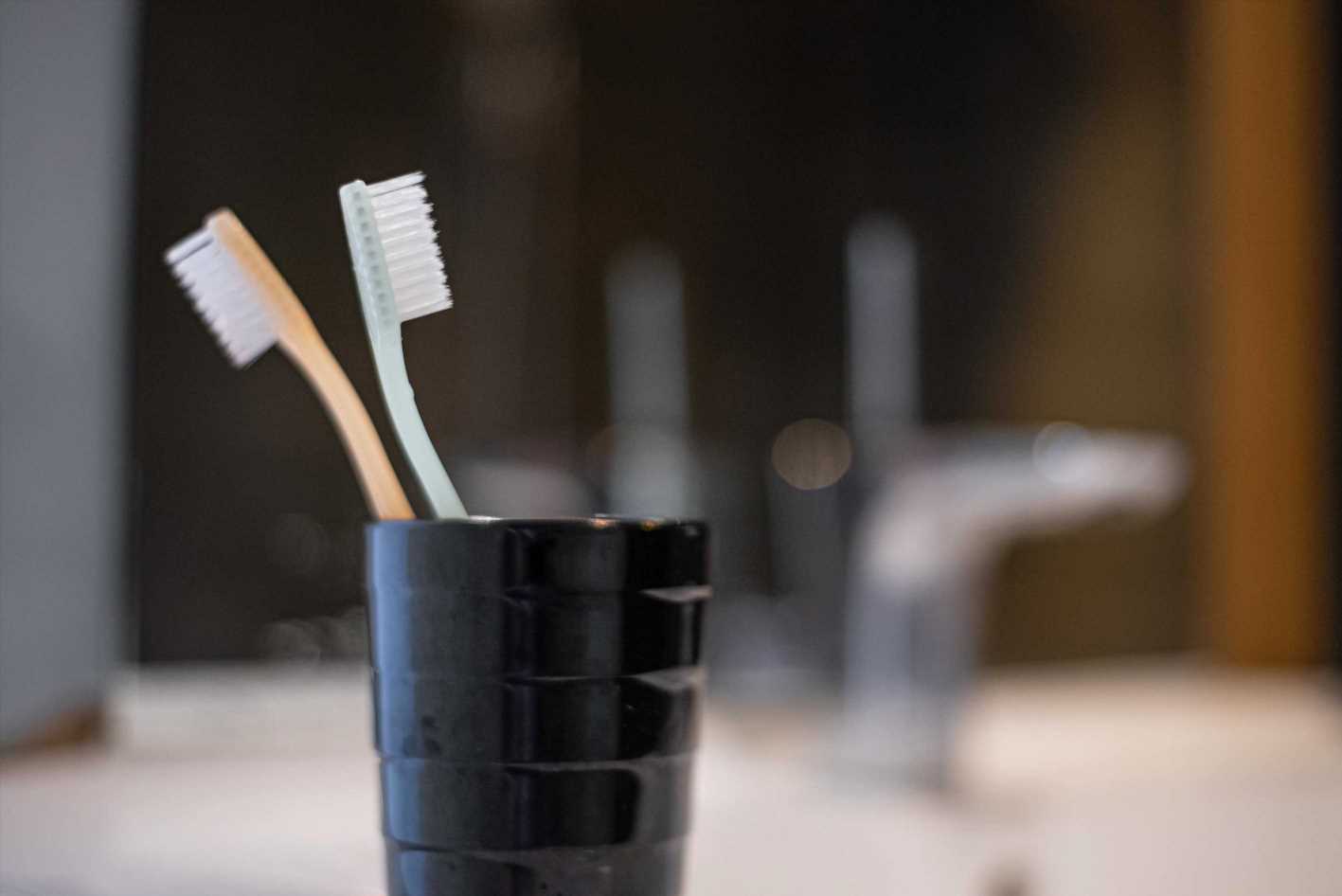How full of weathered and storm-tossed polystyrene can a water-level cave on Sydney Harbour get?
The answer is “jam packed”, according to two artists in residence at Q Station, the former quarantine station on North Head at Manly.
Jane Gillings and Lucy Barker with their exhibition Poly.glut, made from fragments of polystyrene found near Q Station.Credit:Oscar Colman
Jane Gillings and Lucy Barker found the cave while exploring Q Station when their residency, in the old weatherboard doctors’ and nurses’ living quarters, started last March.
The artists crawled into the shallow cave on their stomachs, raked out the detritus and hauled it up the cliff in nets and bags. “We got very good at being filthy,” Gillings said.
The tumbled fragments of polystyrene that began life as bodyboards, buoys, coolers and consumer packaging will go on view at Q Station later this month in an exhibition of work by the two artists called Poly.glut.
Gillings, of Avoca, and Barker, of Wahroonga, made objects from the polystyrene and other ocean garbage and created two rooms resembling the private quarters of a 19th-century amateur naturalist.
There’s a bust of a Rococo gentleman in robes, a cabinet of fossils, a judge’s wig, and a faux Grecian urn depicting a runner with a takeaway coffee cup. All are made from polystyrene and other found materials.
One sculpture was inspired by Pompeii, but the artists imagined the huddled figure had been buried in an onslaught of waste rather than volcanic ash.
In a discovery room, visitors will be able to handle various objects and see how weathered polystyrene can look uncannily like sea urchins or loaves of sourdough bread.
There’s a piece of black yoga mat that’s been pecked by birds. Birds that swallow ocean plastics such as polystyrene are known to die of starvation because they assuage their hunger without ingesting nutrients.
As for the Victorian-era silhouette of a familiar face, it is indeed Thomas Keneally. The celebrated author was “delighted and intrigued” when he met the two artists on his morning walk through the 30 hectares of Q Station during their residency.
Author Thomas Keneally met the two artists on his morning walk.Credit:Oscar Colman
“I’m always up for subversion,” the writer, 86, said. “I think everything they’ve made here is really wonderful. They’ve given the polystyrene weight that it doesn’t have. There’s a mischievous imagination behind it. I could never have thought to do with this material what they’ve done, giving it the irony and the gravity that it has when you see it.”
One of the polystyrene art objects resembles a fragment of an ancient mosaic. Keneally was reminded of the Roman mosaic he saw in Chichester Cathedral, except that one wasn’t bearing the logo of a popular hamburger chain.
While Australian environment ministers have agreed on a national phase-out of polystyrene food packaging by 2025, a global treaty to address marine plastic pollution is needed, according to Kate Noble, No Plastics in Nature Policy Manager at WWF-Australia.
“A staggering 8 million tonnes of plastic ends up in the world’s oceans each year and plastic dumped in one region can travel and impact others. This is a global disaster that requires a global response,” Noble said.
The global problem of ocean waste is a shared passion for Gillings and Barker, who both make art from consumer discards and are regular exhibitors in Sculpture by the Sea and elsewhere.
“We work in a similar style – eclectic and materials based,” Gillings said.
Gillings said the views of the harbour from Q Station are deceptively pristine. “It’s just crazy that [the ocean-borne pollution] is all still out there,” she said.
Will the cave that yielded so much art material fill up with waste again? “Oh yeah, I expect it to be full again now,” Gillings said.
Apart from polystyrene, the artists salvaged coal, tennis balls, bits of glass and other discards that made their way into the art objects.
Poly.glut might have a longer shelf life than just at Q Station. The artists plan to enter the installation in various art prizes, and hope it will be shown in regional galleries.
Poly.glut opens at Q Station on Saturday, January 22. An exhibition of sculptures rejected from Sculpture by the Sea is on at Q Station now until the end of January. Entry to both exhibitions is free.
A cultural guide to going out and loving your city. Sign up to our Culture Fix newsletter here.
Most Viewed in Culture
From our partners
Source: Read Full Article




